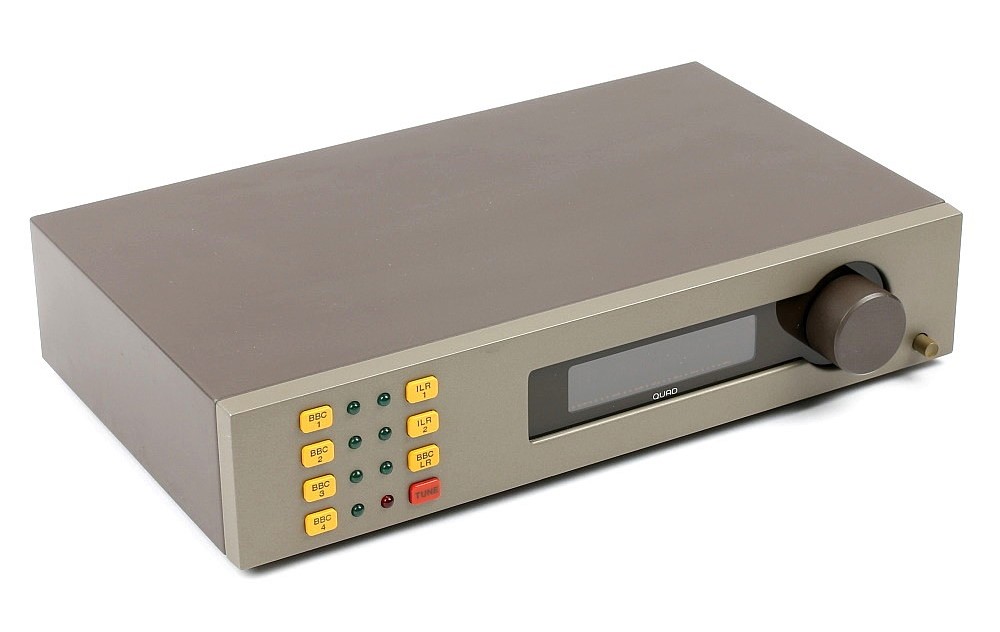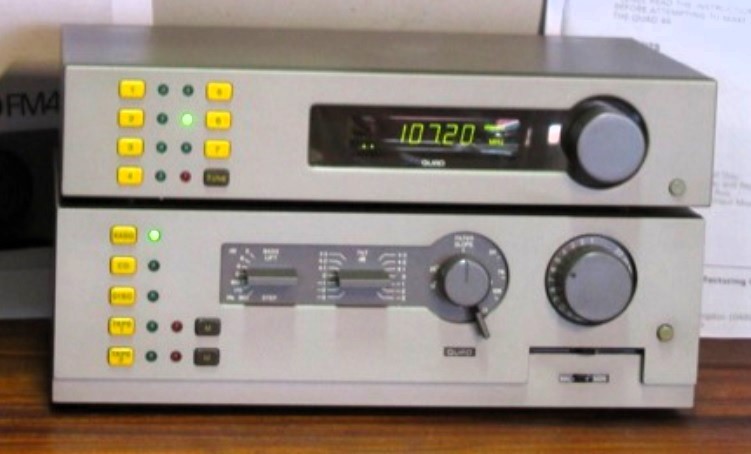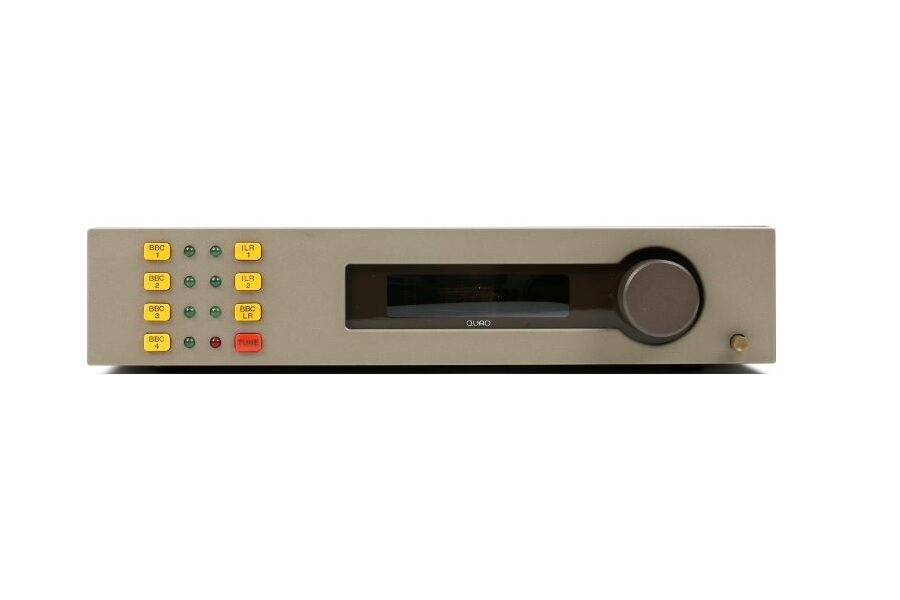Tuner technology peaked in the 1970s and 1980s when Kenwood, Sansui, Marantz, McIntosh etc. introduced tuners with respectable measurements, and sound quality that is still difficult to beat. Along with many expensive classics, there are numerous competent but less expensive tuners on the second hand market, by eg. Pioneer, Sansui, Marantz, Yamaha, Sony, Teac, Kenwood, Onkyo, Luxman and Technics. If in a good condition, these tuners are capable of the same level of performance than more recent tuners by eg. NAD, Creek, Arcam, Cambridge Audio and Rotel, for the same money. NAIM NAT05 is more expensive but it too offers an excellent tuner sound.
And then there is the Quad FM4. Quad (Acoustical Manufacturing Co. Ltd., Huntington) manufactured the FM4, to go with the Quad 44 preamplifier and 405-2 power amplifier, from 1982 to 1995. By early 80s Quad’s previous tuner, the FM3, already had 10 years behind it and was technically a little wanting.
The Quad FM4 is a manual FM tuner (no AM receiver) with seven presets. The tuning frequency range extends to 88 – 108 Mhz (87.9 was available and audible). Back in the 1980s, Quad fans feared that Quad would make the FM4 their first all-digital tuner. Didn’t happen. The FM4 does hide a digital microprocessor, but it only handles the digital display and station preselection. Otherwise, it represents purely traditional analog tuner technology: input is connected to the RF stage via a transformer and from there the signal passes through a band-pass filter to the balanced mixer and the IF amplifier with a ceramic filter. The audio signal goes through an LC filter controlling the channel separation to a phase-locked stereo decoder before filtering and buffering. Tuning is accomplished by driving a reverse voltage across adjustable capacitor diodes within the tuned circuits.
Quad FM4 Tuner is a compact (321 x 64 x 207mm) and solid (3kg) device with that simple but no nonsense style Quad is known of. The front panel features a power switch, tuning knob and preset buttons. The screen makes it easy to check when the signal is at its strongest and equally strong on both channels. Locking to the tuning frequency and muting between transmission frequencies occurs automatically. There is no adjustment of the width of the intermediate frequency band.
The only antenna slot is for a 75 ohm coaxial cable for connecting to the central antenna network. Other antennas are not recommended. The best noise ratio (70dB) is achieved with a signal of 1mV-100mV.
Like all Quads, the Quad FM4 Tuner is well made. Even so, it is worth checking the condition of the power supply (leakage), the digital display etc. when buying a used one. Quad itself says in its service manual that the IC used as an IF amplifier is weak and must be replaced with another one (CA3053S), as it did in later units. The claimed sensitivity is 2.7uV (FM), selectivity 53dB, noise ratio 70dB, distortion 0.15%. As to the frequency response, the Quad reports a typical 20Hz to 15kHz (FM). The price of a used Quad FM4 is somewhere between 150-300 euros. No shortage.

GREAT SOUND BUT NOT THE ABSOLUTE BEST
A few points before auditioning. First, the Quad only has a DIN input, which means that for modern pre/amplifiers, the interconnect cable must split into two RCA sockets at the other end. Second, the FM4’s output voltage is only around 100mV, so more voltage amplification is needed than on average. However, having experimented with several amplifiers, I’d say that the low output of the FM4 rarely poses a problem. Third, FM4 was designed for a 100 kOhm load, such that can be found e.g. in Quad preamplifiers. 50 kilo-ohms works fine too, but with 10 to 20 kilo-ohm of some preamplifiers, the bass reproduction of the FM4 may be affected.
Over the years I have listened to the FM4 next to a number of FM tuners, old and new ones, from a couple hundred euros to several thousands, including the aforementioned Naim NAT05, Magnum Dynalab and Accuphase T-1000 etc. etc. On every occasion, I’ve been mostly satisfied, sound-wise, with what the FM4 is capable of. Systematically so. It might have not always been the winner but nevertheless generated a sound that I could easily live with.
The sensitivity of FM4 in daily use with a roof antenna and in a built-up area has been good enough to let the channels, that are important to me, come out flawlessly and with quite a strong signal, including uncompressed stations with a lower than normal broadcast level. The selectivity (the ability to separate adjacent channels from each other) has also been acceptable.
Compared, for example, to Accuphase T-1000, the Quad FM4 did not quite deliver a similar finesse and cleanliness. That is, the FM4 lags a little behind in the so-called resolution, and this, I’d say, is generally true with respect to top-end tuners. The difference resembles that of a good and excellent cartridge, the latter simply picking up more musically meaningful information from the groove. Another significant difference, when compared to top tuners, is that the Quad FM4 appears to be somewhat limited in bandwidth: not the same treble and especially not the same bass. Compared to the fabulous to McIntosh MR 78, the sound of the FM4 was less mature, not as full and airy. All that notwithstanding, the Quad FM4, in addition to being absolutely reliable, offers a very natural and neutral, trouble-free and competent sound. Among all the devices that I’ve owned, the FM4 might well the one that has provided most opportunities to enjoy music.

SOME FINAL THOUGHTS
A person in a Swedish literature program introduced himself by saying:
“Politics has always been important to me. Almost all human activity is politics. I’m suspicious of people who don’t care about politics, don’t listen to music or read. Why do people just listen to the radio? Why don’t they choose their own music?”
Why do people “just listen to the radio”? A good question. Particularly considering that majority of radio stations seem to broadcast music that is more regressive than progressive, more conventional than experimental, and so and so on. The commercial stations especially. Very few channels choose to encourage genuinely critical or analytical thinking, or enlighten listeners on the music itself. That cognitive approach has been replaced by empty chatter and cheap pleasure. But. There are still radio channels, mostly public, with paid, competent, well-versed and reflective music experts and journalists. With their knowledge and carefully prepared reflections these channels often are able to offer new perspectives and value, and thereby deepen the listeners’ musical awareness. It pays to follow the radio precisely because of these few quality channels.
Second, we are so accustomed to conceive Hi-Fi in terms of sonic identity between the original (whatever that is) performance and the reproduced one, that we fail to see that what ultimately distinguishes a live performance from its reproduction, is not the sound but, obviously, “time”. The actual performance and its Hi-Fi playback almost always happen at different times, with one major exception: FM radio and its live broadcasts! It is true that direct broadcasts are nowadays offered as digital streams too, but hundreds of thousands FM tuners still around, the FM radio is the device with which people can maintain the temporal identity between the original performance (typically concerts of symphony orchestras) and the reproduced one. These radio broadcasts I’d say come closest to an authentic performance.
The third reason to listen to radio, somewhat surprisingly, is technical. The best radio channels (public broadcast companies) use compression (or other sound changing maneuvers) very carefully throughout the entire recording and transmission chain. Add that to how the skilled and experienced radio sound engineers are able to conjure a fantastic spatial sound from the concert hall where they work evening after another. As a result, the sound of a live broadcast from these venues can be of quality rarely heard on a record. Hi-Fi enthusiasts who appreciate the illusion of being there (in the concert hall) should definitely fall on their knees in front of a FM tuner.
Also, people generally think that in terms of sound quality the tuner can’t reach the level of, say, a CD player. I’m inclined to disagree. It would be good for everyone to test their prejudices as to how theoretical or real the differences in measurement values are in practice. That can be done by directing a signal, corresponding to a FM signal, to the tuner’s antenna connection directly from a radio transmitter or FM measurement transmitter, eliminating all problems normally caused by the reception of the signal. The sound produced in this way can then be compared to the sound of a CD player connected to the tuner via the transmitter. My own experience (I once made the test) is that under these conditions it is almost impossible to distinguish a high-quality tuner from a CD player. Subjective differences, if any, are mostly meaningless. I didn’t do a blind test because I knew I would have failed. I’m sure that people would be surprised to hear how close a FM tuner can come to a digital player.
An entirely different question is whether the analog sound of a tuner ought to be compared to the digitally produced one in the first place? When CD players entered the market early 1980s, many dealers and importers thought the correct way to evaluate the sound of a turntable would be to compare it to that of a CD player. Why on earth? A turntable that would sound like a CD player is pretty much the worst one would expect from a turntable. It’s the analog sound of the turntables – and tuners – that we cherish.








